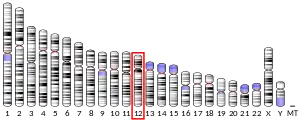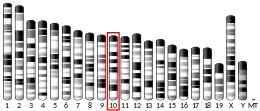Monocarboxylate transporter 2
Monocarboxylate transporter 2 (MCT2) also known as solute carrier family 16 member 7 (SLC16A7) is a protein that in humans is encoded by the SLC16A7 gene.[5] MCT2 is a proton-coupled monocarboxylate transporter. It catalyzes the rapid transport across the plasma membrane of many monocarboxylates such as lactic acid, branched-chain oxo acids derived from [[leucine, valine, and isoleucine, and the ketone bodies acetoacetate and beta-hydroxybutyrate. It also functions as high-affinity pyruvate transporter.
| SLC16A7 | |||||||||||||||||||||||||||||||||||||||||||||||||||
|---|---|---|---|---|---|---|---|---|---|---|---|---|---|---|---|---|---|---|---|---|---|---|---|---|---|---|---|---|---|---|---|---|---|---|---|---|---|---|---|---|---|---|---|---|---|---|---|---|---|---|---|
| Identifiers | |||||||||||||||||||||||||||||||||||||||||||||||||||
| Aliases | SLC16A7, MCT2, solute carrier family 16 member 7 | ||||||||||||||||||||||||||||||||||||||||||||||||||
| External IDs | OMIM: 603654 MGI: 1330284 HomoloGene: 20990 GeneCards: SLC16A7 | ||||||||||||||||||||||||||||||||||||||||||||||||||
| |||||||||||||||||||||||||||||||||||||||||||||||||||
| |||||||||||||||||||||||||||||||||||||||||||||||||||
| |||||||||||||||||||||||||||||||||||||||||||||||||||
| |||||||||||||||||||||||||||||||||||||||||||||||||||
| |||||||||||||||||||||||||||||||||||||||||||||||||||
| Wikidata | |||||||||||||||||||||||||||||||||||||||||||||||||||
| |||||||||||||||||||||||||||||||||||||||||||||||||||
Both Northern blot analysis and inspection of the human expressed sequence tag (EST) database suggest relatively little expression of MCT2 in human tissues. As well, the sequence of MCT2 is far less conserved across species than that of MCT1 or MCT4 and there also appear to be considerable species differences in the tissue expression profile of this isoform.
Of the four known mammalian lactate transporters (MCTs 1-4), MCT2 harbors the highest affinity for lactate.[6] In parallel, MCT2 gene transcription has been demonstrated to respond with high-sensitivity to hypoxia, intracellular pH, and, to lactate.[7]
See also
References
- GRCh38: Ensembl release 89: ENSG00000118596 - Ensembl, May 2017
- GRCm38: Ensembl release 89: ENSMUSG00000020102 - Ensembl, May 2017
- "Human PubMed Reference:". National Center for Biotechnology Information, U.S. National Library of Medicine.
- "Mouse PubMed Reference:". National Center for Biotechnology Information, U.S. National Library of Medicine.
- Garcia CK, Goldstein JL, Pathak RK, Anderson RG, Brown MS (Apr 1994). "Molecular characterization of a membrane transporter for lactate, pyruvate, and other monocarboxylates: implications for the Cori cycle". Cell. 76 (5): 865–73. doi:10.1016/0092-8674(94)90361-1. PMID 8124722. S2CID 22137883.
- Halestrap AP (Jan 2012). "The monocarboxylate transporter family--Structure and functional characterization". IUBMB Life. 64 (1): 1–9. doi:10.1002/iub.573. PMID 22131303. S2CID 24460891.
- Caruso JP, Koch BJ, Benson PD, Varughese E, Monterey MD, Lee AE, Dave AM, Kiousis S, Sloan AE, Mathupala SP (Feb 2017). "pH, Lactate, and Hypoxia: Reciprocity in Regulating High-Affinity Monocarboxylate Transporter Expression in Glioblastoma". Neoplasia. 19 (2): 121–134. doi:10.1016/j.neo.2016.12.011. PMC 5238458. PMID 28092823.
Further reading
- Pértega-Gomes N, Vizcaíno JR, Gouveia C, Jerónimo C, Henrique RM, Lopes C, Baltazar F (2013). "Monocarboxylate transporter 2 (MCT2) as putative biomarker in prostate cancer". Prostate. 73 (7): 763–9. doi:10.1002/pros.22620. hdl:1822/24037. PMID 23192371. S2CID 5816396.
- Lee I, Lee SJ, Kang WK, Park C (2012). "Inhibition of monocarboxylate transporter 2 induces senescence-associated mitochondrial dysfunction and suppresses progression of colorectal malignancies in vivo". Mol. Cancer Ther. 11 (11): 2342–51. doi:10.1158/1535-7163.MCT-12-0488. PMID 22964484.
- Cheng C, Edin NF, Lauritzen KH, Aspmodal I, Christoffersen S, Jian L, Rasmussen LJ, Pettersen EO, Xiaoqun G, Bergersen LH (2012). "Alterations of monocarboxylate transporter densities during hypoxia in brain and breast tumour cells". Cell Oncol (Dordr). 35 (3): 217–27. doi:10.1007/s13402-012-0081-9. PMC 3396336. PMID 22700320.
- Lauritzen F, Heuser K, de Lanerolle NC, Lee TS, Spencer DD, Kim JH, Gjedde A, Eid T, Bergersen LH (2012). "Redistribution of monocarboxylate transporter 2 on the surface of astrocytes in the human epileptogenic hippocampus". Glia. 60 (7): 1172–81. doi:10.1002/glia.22344. PMC 3664041. PMID 22535546.
- Halestrap AP (2012). "The monocarboxylate transporter family--Structure and functional characterization". IUBMB Life. 64 (1): 1–9. doi:10.1002/iub.573. PMID 22131303. S2CID 24460891.



